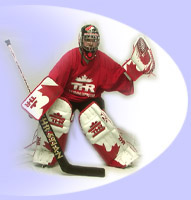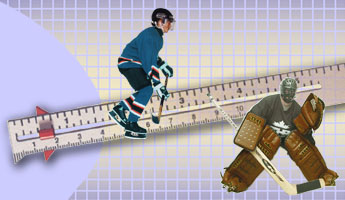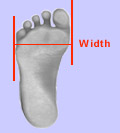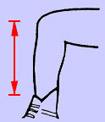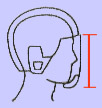| SKATES
|
 |
|
|
Generally,
skates will fit 1 to 1 ½ sizes smaller than your shoe size. For
women, this size is 2 to 2 ½ sizes smaller. CCM skates tend to
be wider, and Bauer's tend to be narrow. If you have wide feet,
you might find CCM's are much more comfortable, whereas if you
have narrow feet, you might find them too loose. In the end however,
a proper fit is determined by trying on a number of different
types and sizes and feeling which ones are most comfortable.
When
trying the skate on, you should kick your heel into the very back
of the boot, and your toes should only barely be able to feel
the toe cap. If they curl, or are crushed in any way, the boot
does not fit properly. As you lace up the boot, be sure to kick
your heel back so that it stays firmly locked against the back
of the boot. Laces should be snug, but not too tight. Common practice
is to have looser lacing along the front of the footbed, tighter
lacing along the part of your foot where the ankle meets the foot,
and then slightly looser up near the top. When completely laced,
eyelets should be 1.5 to 2" apart. If further apart, a wider boot
would be better. And if the eyelets are closer, look for a narrower
boot.
When
the skates are laced, get up and walk around. The heels should
remain firmly against the back of the skate. If it slips or there
is movement, then the skate is too large. Your foot should be
comfortable in the footbed, and your toes should be able to lie
flat in the boot. It is always a good idea to take the skates
off completely and trying them on again before making any final
decisions. Red areas or pressure points on your feet are signs
of an improperly fitted skate.
When fitting children, remember not to fit them too large, even
though some room for growth should be given. It is wise to only
have about a half an inch between the heel and the boot when their
foot is pushed up as far as it can go into an unlaced boot. Also,
remember to buy them as close to the season they need them for
as possible, so that they give you more wear before you must buy
another pair.
The following table outlines the various foot measurement systems
in use:
|
|
Shoe
Size Conversion Chart
|
|
Shoe
Sizes (Canada/USA)
|
Mondopoint
(cm)
|
Europe
|
U.K.
|
Women
(USA)
|
|
8
|
15
|
25
|
7
|
-----
|
|
9
|
16
|
26
|
8
|
-----
|
|
10
|
17
|
27
|
9
|
-----
|
|
11
|
17.5
|
28
|
10
|
-----
|
|
12
|
18.5
|
29
|
11
|
-----
|
|
13
|
19.5
|
30.5
|
12
|
-----
|
|
13.5
|
20
|
31
|
13
|
-----
|
|
1
|
20.5
|
32
|
13.5
|
-----
|
|
2
|
21
|
33
|
1
|
-----
|
|
3
|
21.5
|
34
|
2
|
-----
|
|
4
|
22
|
35
|
3
|
5
|
|
4.5
|
22.5
|
36
|
3.5
|
5.5
|
|
5
|
23
|
36.5
|
4
|
6
|
|
5.5
|
23.5
|
37
|
4.5
|
6.5
|
|
6
|
24
|
38
|
5
|
7
|
|
6.5
|
24.5
|
38.5
|
5.5
|
7.5
|
|
7
|
25
|
39
|
6
|
8
|
|
7.5
|
25.5
|
40
|
6.5
|
8.5
|
|
8
|
26
|
40.5
|
7
|
9
|
|
8.5
|
26.5
|
41
|
7.5
|
9.5
|
|
9
|
27
|
42
|
8
|
10
|
|
9.5
|
27.5
|
42.5
|
8.5
|
10.5
|
|
10
|
28
|
43
|
9
|
11
|
|
10.5
|
28.5
|
44
|
9.5
|
11.5
|
|
11
|
29
|
44.5
|
10
|
12
|
|
11.5
|
29.5
|
45
|
10.5
|
-----
|
|
12
|
30
|
45.5
|
11
|
-----
|
|
12.5
|
30.5
|
46
|
11.5
|
-----
|
|
13
|
31
|
47
|
12
|
-----
|
|
13.5
|
31.5
|
47.5
|
12.5
|
-----
|
|
14
|
32
|
48
|
13
|
-----
|
|
14.5
|
32.5
|
48.5
|
13.5
|
-----
|
|
15
|
33
|
49
|
14
|
-----
|
|
15.5
|
33.5
|
50
|
14.5
|
-----
|
|
16
|
34
|
51
|
15
|
-----
|
|
| Notes* |
| 1)
Bauer skates fit 1 to 1 ½ sizes smaller than your shoe size.
(e.g. size 6 ½ shoe will require a 5 ½ Bauer skate. |
| 2)
Women's' skates are usually 2 sizes above men's' skates (e.g.
a 5 ½ men's skate is equivalent to a 7 ½ women's skate which
is equivalent to an 8 ½ women's shoe size). |
| 3)
Graf skates fit one size smaller than shoe size. |
| 4)
Easton
skates fit 1 ½ sizes smaller than shoe size. |
| 5)
CCM skates fit 1 ½ to 2 sizes smaller than shoe size.
|
| 6)
Mission
and Nike Ibrite series skate fit same as shoe size. |
| 7)
Nike Quest series skates fit ½ size smaller than shoe
size. |
| 8)
Shoes measured in mondopoint fit same size skate measured
in mondopoint (e.g. skate size 27 fits shoe size 27) |
| 9)
Above sizes apply only to hockey boot style skates, moulded
boots with liner, or figure skates normally fit same as shoe
size. |
| *Above
comments are guidelines only |
| If
a skate measuring scale, or a local hockey store is not available
to you, we can determine your skate size if you provide us
with the following information: |
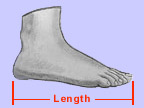 |
|
1) Place sheet of paper on floor |
| 2)
Next place heel of foot against a flat vertical
surface, such as a wall |
| 3)
Mark off tip of toe and measure distance in inches
|
|
|
| |
|
|
|
1) Measure across widest part of foot in
inches. |
| 2)
Standard skate width is called a "D" width. |
| 3)
Most skate makers also have C, E, EE, and EEE
widths - triple E being the widest. |
|
|
| Note:
Both right and left foot needs to be measured since it's common
to have one foot larger than the other. |
|
| SHIN
PADS |
 |
|
|
|
|
Ensure that the cap of the shin pad is centered on the
kneecap. The calf padding should wrap around the lower
leg. |
| Measure
from the center of the kneecap to the top of the skate
boot (or 1" above the inside ankle). Match the
player's shin size to the inches of the shinguards. |
Size
Measurements
Youth 8" to 11"
Junior 12" to 13"
Senior 14" to 17" |
|
|
| ELBOW
PADS |
 |
|
 |
|
The top of the elbow pad should meet the bottom of the
arm of the shoulder pad and extend down the forearm
to the top of the glove |
| The
elbow pad should not restrict movement of the elbow.
With the elbow pads on, test the range of motion by
bending the arm at the elbow, watching for restriction. |
|
|
| SHOULDER
PADS |
 |
|
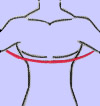 |
Shoulder caps should
fit right over the shoulder tips. The arm pads should extend
to just above the elbow to ensure full protection. Pads should
not be too restrictive and should allow for freedom of movement.
For sizing, measure around the chest just below your armpits.
|
|
| Junior
Sizes |
L
= 28" to 30"
|
Senior Sizes
|
XL
= 42" to 44"
|
| |
M
= 24" to 28"
|
|
L = 38" to 42"
|
| |
S
= 22" to 24"
|
|
M
= 34" to 38"
|
| |
XS
= 20" to 22"
|
|
S
= 30" to 34"
|
|
| HOCKEY
PANTS |
 |
|
| Pants
should cover from just above the knee, up to the kidneys and lower
ribs. Pants should not be too tight or restrictive. |
|
Waist
Size
|
European
Sizing
|
Standard
Sizing
|
Approximate
Height
|
|
17"
- 19"
|
Jr 100 - 110
|
X-SML
|
3'-4"
to 3'-7"
|
|
20"
- 23"
|
120
- 130
|
SML
|
3'-8"
to 4'-3"
|
|
24"
- 26"
|
140
- 150
|
MED
|
4'-4"
to 4'-11"
|
|
27"
- 29"
|
160
- 180
|
LGE
|
5'-0"
to 5'-5"
|
|
29"
- 30"
|
Sr
46
|
SML
|
5'-6"
|
|
31"-
32"
|
48
|
SML
|
5'-6"
to 5'-8"
|
|
32"
- 33"
|
50
|
MED
|
5'-8"
|
|
34"
- 35"
|
52
|
MED
|
5'-10"
|
|
36"
- 38"
|
54
|
LGE
|
6'-0"
|
|
39"
- 42"
|
56
|
XL
|
6'-2"
|
|
42"
- 44"
|
58
|
XL
|
6'-2"
|
|
44"
- 46"
|
60
|
XXL
|
6'-4"
and over
|
|
|
|
Womens
Sizing
|
|
|
Waist
Size
|
|
Pant
Size
|
|
24"
- 26"
|
|
XS
|
|
26"
- 28"
|
|
S
|
|
29"
- 31"
|
|
M
|
|
32"
- 34"
|
|
L
|
|
36"
- 38"
|
|
XL
|
|
38"
- 40"
|
|
XXL
|
|
| HOCKEY
GLOVES |
 |
|
|
|
Measure
the distance from your fingertips halfway up the forearm.
Gloves should fit like loose winter gloves over the fingers.
The top of the glove needs to extend up to the forearm to
the bottom of the elbow pads. (except short cuff fit.)
Size
Measurements
Youth 9" to 10"
Junior 11" to 13"
Senior 14" to 16"
|
|
| HELMETS
|
 |
|
|
The
areas to consider when choosing a helmet are protection, comfort
and fit. You should always look for equipment that feels comfortable.
The helmet should be adjusted to fit snug to prevent any shifting
and maximize protection. Make sure the chinstrap is adjusted so
it gently makes contact under the chin when fastened.
It
is recommended that the player wears CSA and HECC certified helmets.
All CSA and HECC certified helmets have a sticker indicating their
certification. Open your helmet to it's largest setting and place
it on the head so that the rim is one finger width above the eyebrow.
Gradually begin to downsize the helmet until a comfortably snug
fit is achieved.
|
|
Helmet
Size
|
Hat
Size
|
Circumference
(inches)
|
|
X-Large
|
7
3/4 - 8 1/4
|
24.5
- 26.5
|
|
Large
|
7
1/8 - 8 3/4
|
22.5
- 24.5
|
|
Medium
|
6
7/8 - 7 1/2
|
21.5
- 23.5
|
|
Small
|
6
1/2 - 7 1/8
|
20.5
- 22.5
|
|
|
Hat
size method - measure from the top of one ear to the other
ear crossing over the top of your head.
Circumference
method - measure around the forehead.
|
| FACEMASK
|
 |
|
|
|
The
facemask should fit snugly to the chin. If it is too long,
it may come into contact with the nose and mouth during
impact.
When
the player's mouth is closed, the chin should fit comfortably
into the chin cup. Attach the face mask securely to the
helmet according to instructions provided within the product
packaging.
|
|
| NECK
PROTECTOR |
 |
|
|
Neck
guards are designed to protect the throat area from lacerations
and cuts - they are not designed to protect against spinal injuries.
The
neck guard should be snug, but not uncomfortably tight. It should
completely cover the throat, and with the bib style, the upper
chest area. Measure the player's neck and match this size to the
adjacent sizing chart.
Junior:
11" to 14"
Senior:
14" to 18"
Neck
protector must have a BNQ certification label.
|
| HOCKEY
STICK |
 |
|
| To
measure a stick stand without skates in your stocking feet - top
of stick should touch the tip of your nose. When standing on skates,
the top of the stick should come up to the bottom of your chin.
Stick length and stick blade patterns comes down to personal preference,
defensemen may want to use a longer stick to give them a longer
reach for poking the puck away, and forwards may want to use a shorter
stick to help them stickhandle better. |
| MOUTH
GUARD |
 |
|
|
Athletic mouthguards are an essential piece of safety equipment.
Mouthguards not only significantly reduce the incidence and severity
of injuries to the teeth and mouth, but they also act as a shock
absorber against more serious injuries like concussions and jaw
fractures. A good mouthguard, such as Shock Doctor® mouthguard
will offer the following protection:
- Protect the brain from concussion by absorbing and dissipating
the shock of a blow to the lower jaw
- Protect the temporomandibular (jaw) joint from dislocation
and other injury by supporting and cushioning the lower jaw
- Protect the jaw from fractures by providing a cushion between
upper and lower jaw
- Protect against broken, chipped, lost or nerve damaged teeth
by absorbing and deflecting the force of a blow
- Protect oral tissues from laceration by shielding the lips,
tongue, cheeks and gums
|
| ATHLETIC
SUPPORTER AND CUP |
 |
|
| Is
fitted according to waist size, some jock straps incorporate the
garter belt, and some are incorporated with loose shorts - style
is a matter of personal preference. |
| GARTER
BELTS |
| Holds
up hockey socks and is fitted according to waist size. |
| SUSPENDERS |
| Holds
up hockey pants and is fitted according to body height. |
| SHIN
STRAPS/TAPE |
| Holds
shin pads in place, straps come in junior or senior sizes. Tape
is generally of a poly (plastic) material and can be either clear
or coloured. |
| HOCKEY
SOCKS/JERSEY |
| Generally
mandated by the team. Sizing should not be too small or constrictive. |
|
GOAL
EQUIPMENT
|
| GOAL
PADS |
 |
|
|
|
- Measure
distance from inside ankle to the centre of the knee,
while leg is slightly bent.
- Measure
distance from centre of knee up the thigh to desired height,
usually 4" to 8".
- Add
the 2 measurements to your goal skate size.
Example:
16" + 6" + 10 (skate size) = 32".
|
|
| Generally
your knee should fit slightly below the centre knee roll of the
pad. Once the pads break in, your knee will be directly behind the
centre knee roll. The top two straps on a goal pad should be worn
loose.The
first reason is most knee locks, knee cradles, and thigh guards,
hold you in the pad and allow the pad to move properly with your
leg. The second reason is your goal pant should break across the
top of your knee cap, riding behind the top of the pad. This double
coverage increases protection and allows for better mobility. |
| CATCHER
AND BLOCKER GLOVES |
 |
|
| Your
arm/chest pads and catcher/blocker gloves should provide continuous
protection for the length of your arm and hand. The cuff of your
catcher/blocker gloves should extend one to two inches over the
bottom of the arm protection on your arm/chest pads. To protect
your fingertips, your fingers should not go all the way to the end
of the gloves. Catcher and blocker gloves are sold in 'Regular'
and 'Full Right' styles. 'Regular' is for right-handed players who
use their left hand for the catcher glove and their right hand for
the blocker and stick. 'Full Right' is for left-handed players who
use their right hand for the catcher glove and their left hand for
the blocker and stick. |
| CHEST
AND ARM PROTECTORS |
 |
|
| Goalie
chest and arm pads protect your upper body and arms. For proper
protection, your shoulders should fit comfortably into both shoulder
cups and the pad should extend down to your waist. A variety of
straps will allow you to adjust the fit for arms, chest and back.
You should also make sure that the arms can be adjusted so that
your elbows fit comfortably into the elbow cups. If the arms are
too long, they will interfere with your catcher and blocker gloves.
The arms should extend 1 ½ inches above your wrist bone. Your catcher
and blocker gloves should extend up over the bottom of your arm
pads. Arm & chest pads are sized based on the chest size and height
of the goalie. |
| |
Size
|
Chest
Size
|
Height
|
|
Adult
|
XL
|
44"-48"
|
6'-0"
to 6'-5"
|
| |
L
|
40"-44"
|
5'-10"
to 6'-0"
|
| |
M
|
36"-40"
|
5'-6"
to 5'-9"
|
| |
S
|
32"-36"
|
5'-3"
to 5'-5"
|
|
JR
|
XL
|
30"-32"
|
4'-11"
to 5'-2"
|
| |
L
|
28"-30"
|
4'-6"
to 4'-11"
|
| |
M
|
24"-28"
|
4'-4"
to 4'-5"
|
| |
S
|
20"-24"
|
4'-0"
to 4'-5"
|
|
| GOAL
PANTS |
 |
|
Goal
pants have additional padding in the inner thigh section.
| Waist
Size |
Junior
Sizes |
|
Waist
Size |
Senior
Sizes |
| 22"-23" |
120
(SM) |
|
28"-29" |
46 (XXSML) |
| 24"-25" |
140
(MED) |
|
29"-30" |
48 (XSML) |
| 26"-27" |
160
(LG) |
|
30"-31" |
50 (S) |
| 28"-30" |
180
(XL) |
|
32"-33" |
52 (M) |
| |
|
|
34"-35" |
54 (L) |
| |
|
|
36"-37" |
56 (XL) |
| |
|
|
38"-40" |
58 (XXL) |
|
| GOAL
SKATES |
 |
|
|
Goals skates are sized similar to player skates. Goal skates
differ from player skates in the following ways:
- Boot is surrounded by hard plastic shell for added protection.
- The height of the boot in relation to the ice is lower, giving
a lower centre of gravity and more stability.
- The
blade is flatter (not rockered), leaving more blade in contact
with the ice, which gives better balance.
|
| GOALIE
HELMET |
 |
|
|
A
goalie helmet has to fit snugly. This allows the shape and composition
of the shell to equally distribute shot pressure. It is recommended
that all goaltenders wear CSA and HECC certified masks. All CSA
and HECC certified masks have a sticker indicating their certification.
When
fitting the goaltender mask, adjust the unit so that the upper
perimeter of the frontal component is ¼ " above the eyebrow. For
a proper fit, make sure all straps are fastened so that the chin
cup fits snugly against the chin and the mask achieves a snug
fit.
|
| GOAL
NECK PROTECTOR |
 |
|
|
A
goalie neck protector gives more protection than a player throat
protector. The protector usually has thicker padding and sometimes
additional plastic inserted between padding. Neck protectors should
also have a BNQ certification label. Sizing is according to neck
circumference.
Junior = 11" to 14"
Senior = 14" to 18"
|
| GOALIE
JOCK |
 |
|
| Goal
jocks are fitted according to wait size. They usually come in either
junior or senior size. The jocks have more padding and cover a larger
area than player jocks. |
| GOAL
STICKS |
 |
|
|
The
following stick characteristics will help you choose the correct
size:
Curves
1. Youth goalies under 10-12 years should not have a curve.
House Leagues should wait a couple more years before buying a
curved stick. Learn to stop the puck before shooting it.
2. Junior goaltenders don't need a huge curve. The bigger
the curve, the bigger the chance of missing a shot at the stick.
Pokechecking is more difficult with a curved stick - the toe of
the stick is off the ice when the blade is pushed forward. In
the backhand position, the puck can easily slide under the curved
area. Curved sticks often cannot be placed totally flat. The blade
is usually rockered which will put the toe up when the heel is
down and vice versa. Rebounds are also much harder to control
off a curved surface as opposed to a straight one.
Shaft Length
In stance with skates on and the stick blade flat on the ice,
the shaft should not be higher than the goalie's shoulder. Buy
a stick that fits. Never cut a goalie stick. They are balanced
and cutting the shaft eliminates that required balance.
Paddle Length
In stance with skates on and the stick blade flat on the ice,
the blocker should be positioned between the waist and the bottom
knee roll on the pad. If the blocker is too low, the goaltender
will lean forward, be off balance and he will have difficulty
with the top corner. If too high, the goaltender will have difficulty
with low shots and stick maneuverability.
Lie
In stance with skates on and the stick blade flat on the ice,
the goaltender must be comfortable. Use the lie number on the
shaft as a guide, but don't rely on each manufacturer's lie to
be the same - they're not even close! (E.g. A Louisville l3 lie
is 2 or 3 inches different from a Koho lie 13). Pro Pattern sticks
often do not show a lie so be careful. The lie signifies the angle
the blade is on. A 13 lie will position the blocker hand further
away from the body and closer to the ice, thus creating a larger
opening under the arm. Using a 15 lie will put the blocker hand
closer to the body and further from the ice. Every goaltender
will like a different lie and this may change during the season
and throughout his/her career. It may be necessary to try several
sticks before finding the correct one. Quite often incorrect glove
positioning is mistaken for incorrect lie. Before rushing to get
a new stick, make sure the hands are in the proper location.
|
|
|
| |
|
|

